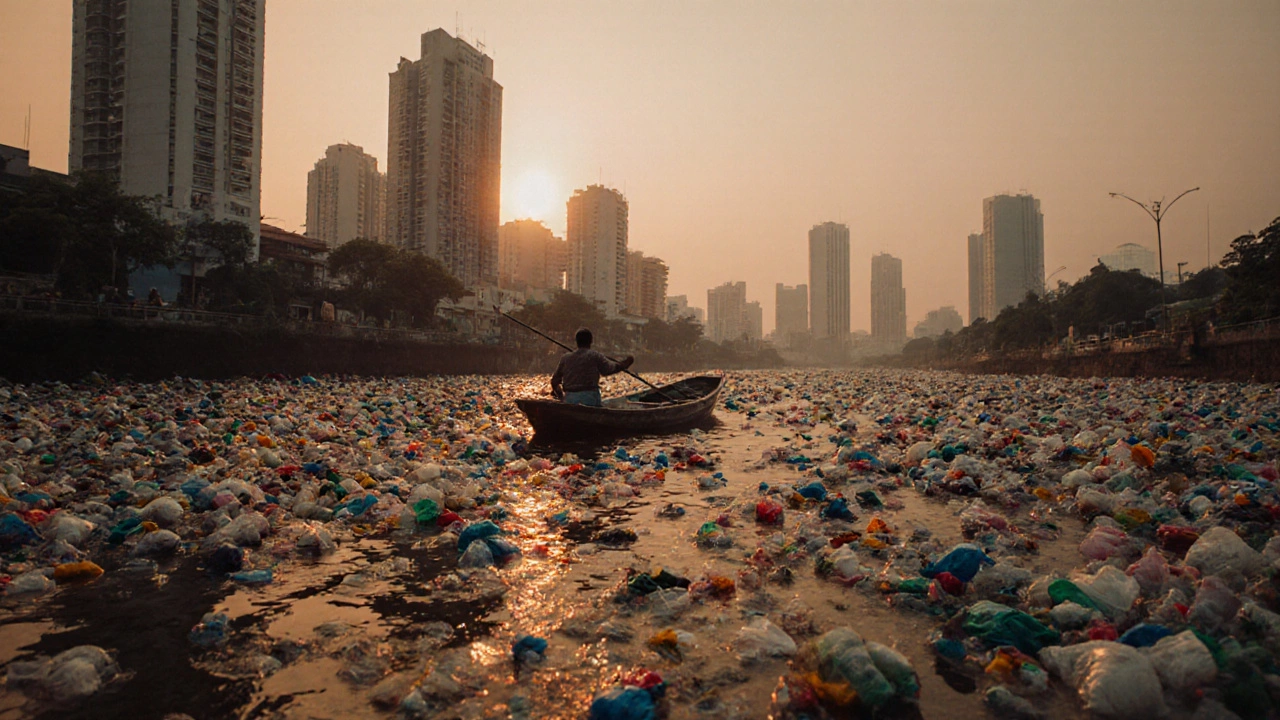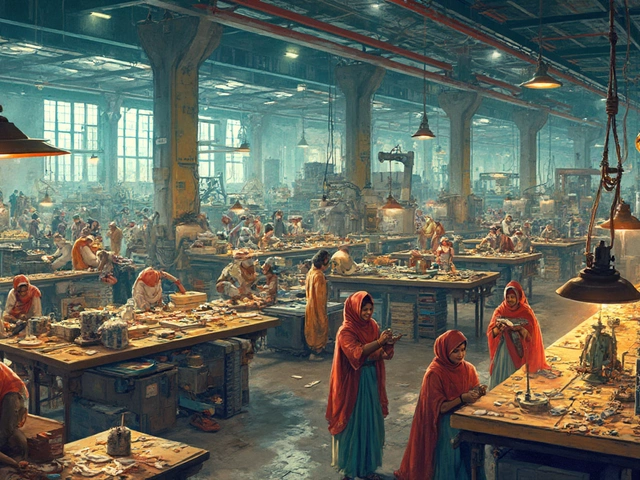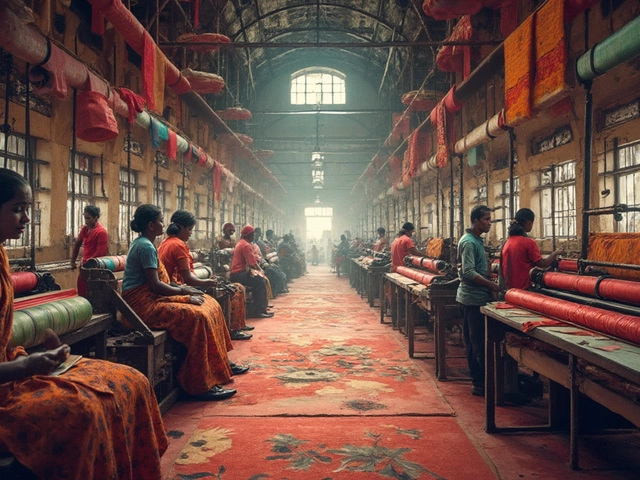
Every year, more than 11 million tons of plastic end up in the ocean. That’s enough to cover every coastline on Earth with five full bags of trash. But not all countries contribute equally. One nation stands out-not because it’s the largest, or the most industrialized, but because of how it handles waste, how much plastic it produces, and how little of it gets recycled. The country putting the most plastic into the ocean isn’t the one you might think.
China used to lead-but it’s not number one anymore
For years, China was blamed as the biggest source of ocean plastic. It made sense: China produced nearly a third of the world’s plastic, shipped most of the planet’s goods, and had weak waste systems in many coastal areas. In 2015, a study from the journal Science estimated China dumped nearly 1.5 million tons of plastic into the sea each year. That number was terrifying. But things changed.
In 2018, China stopped accepting foreign plastic waste. Then, in 2021, it banned single-use plastics in major cities. By 2023, its ocean plastic output had dropped by more than 60%. The country didn’t fix everything overnight, but it moved fast. Today, China is no longer the top contributor. It’s now in the top five-but not the top one.
The real leader: the Philippines
The country currently dumping the most plastic into the ocean is the Philippines. In 2024, the Ocean Conservancy and other research groups confirmed that the Philippines leads with an estimated 360,000 tons of plastic waste entering the sea each year. That’s more than any other nation, even though its population is only about 110 million-less than half of Indonesia’s and less than one-third of China’s.
Why? It’s not because Filipinos use more plastic per person. It’s because the country lacks waste collection infrastructure. In rural areas and informal settlements, trash often ends up in rivers during the rainy season. Those rivers flow straight into the ocean. A single river, the Pasig River in Manila, carries an estimated 63,000 tons of plastic into the sea annually-more than the entire annual output of Germany or France.
Plastic manufacturing companies in the Philippines produce about 3.7 million tons of plastic each year. Most of it is single-use packaging-bags, sachets, bottles. These are cheap, convenient, and sold everywhere. But there’s no system to collect them. Only 14% of plastic waste in the Philippines gets recycled. The rest? Burned in open pits, dumped in landfills that overflow, or washed away by storms.

Other major contributors
The top five ocean plastic polluters in 2025 are:
- Philippines - 360,000 tons
- Indonesia - 320,000 tons
- Vietnam - 280,000 tons
- Egypt - 240,000 tons
- Thailand - 220,000 tons
All of these countries share similar problems: fast-growing populations, booming plastic production, and underfunded waste systems. In Indonesia, for example, 70% of plastic waste comes from urban areas, but only 10% of villages have waste collection. In Vietnam, the government estimates that 90% of plastic bags used daily end up in waterways.
Even countries with strong economies can be big contributors if they export plastic waste. The United States, for instance, produces more plastic per person than any other country-about 130 kilograms per person annually. But because it recycles 9% of its plastic and exports a lot of waste to Southeast Asia, it indirectly fuels ocean pollution. The U.S. shipped over 200,000 tons of plastic waste overseas in 2023-mostly to Malaysia, Indonesia, and Vietnam-where much of it was never properly handled.
Who makes the plastic?
It’s easy to blame consumers. But the real drivers are the companies that make the plastic. The top 20 plastic producers account for 55% of all virgin plastic made globally. Just five companies-ExxonMobil, Dow, Sinopec, Reliance Industries, and BASF-produce more plastic than the entire GDP of most African nations.
These companies aren’t based in the Philippines or Indonesia. They’re headquartered in the U.S., Germany, China, and Saudi Arabia. But they supply plastic to fast-growing markets where recycling doesn’t exist. In the Philippines, 80% of plastic packaging comes from multinational brands like Unilever, Nestlé, and Procter & Gamble. Their products come in single-use sachets-tiny, cheap, and impossible to recycle. A single shampoo sachet costs less than a penny. But when millions are used every day, they become a disaster.
These companies know the problem. They’ve made public pledges to reduce plastic. But in 2024, a report from Greenpeace found that the top 10 plastic producers increased their virgin plastic output by 8% since 2020. They’re betting on growth in developing countries where regulation is weak and enforcement is rare.

What’s being done?
Some countries are fighting back. The Philippines passed the Extended Producer Responsibility Act in 2023, forcing companies to pay for collecting and recycling their packaging. Indonesia launched a national plastic reduction program in 2024, aiming to cut ocean plastic by 70% by 2030. Vietnam is building 300 new waste collection centers in coastal provinces.
But progress is slow. Most solutions focus on cleanup or recycling. But recycling plastic is expensive, energy-intensive, and often impossible. Only 9% of all plastic ever made has been recycled. The rest is landfilled, burned, or dumped. The real fix isn’t better bins-it’s less plastic.
That means companies must stop making so much of it. Governments must ban unnecessary single-use items. And consumers must demand change-not just by recycling, but by refusing.
Can we fix this?
Yes-but not with better recycling programs or beach cleanups. Those help, but they’re treating symptoms, not causes.
The solution is simple in theory: reduce plastic production at the source. That means:
- Banning single-use plastics like sachets, straws, and cutlery
- Forcing manufacturers to use recycled content in new products
- Shutting down plastic exports to countries without waste systems
- Investing in reusable packaging models, not disposable ones
The Philippines didn’t become the top ocean polluter because its people are careless. It happened because the global plastic system was designed to fail. Companies made cheap, disposable products. Governments didn’t build systems to handle them. And now the ocean is paying the price.
The next time you see a plastic bag floating in the sea, remember: it didn’t come from nowhere. It came from a factory. It was packaged by a brand. It was sold for less than a dollar. And no one took responsibility for what happened after it was used.
The problem isn’t just one country. It’s a system. And fixing it means holding the right people accountable-not the ones who throw the trash, but the ones who made it in the first place.
Which country produces the most plastic waste overall?
The United States produces the most plastic waste per capita and overall, generating over 38 million tons annually. But because it recycles a small fraction and exports much of its waste, its direct contribution to ocean plastic is lower than countries like the Philippines and Indonesia, which produce less plastic overall but have almost no waste collection systems.
Is plastic recycling effective at stopping ocean pollution?
No, not really. Globally, only 9% of all plastic ever made has been recycled. Most recycling programs are designed for bottles and containers, not sachets, films, or multi-layer packaging-exactly the types of plastic most common in developing countries. Even when plastic is collected, it often ends up in landfills or is burned. Recycling alone can’t solve ocean plastic pollution.
Do plastic manufacturing companies care about ocean pollution?
Many make public promises, but few take real action. In 2024, Greenpeace found that the top 10 plastic producers increased their virgin plastic output by 8% since 2020. They rely on growth in markets with weak regulations. Their business model depends on selling cheap, disposable plastic-so reducing it would hurt profits. Real change requires legal pressure, not voluntary pledges.
Why do countries like the Philippines have so much plastic waste?
It’s not because people use more plastic-it’s because there’s no system to collect it. In rural areas, trash isn’t picked up. In cities, landfills overflow. Plastic packaging like sachets is cheap and popular, but impossible to recycle. Rivers carry the waste to the sea. The problem isn’t laziness-it’s lack of infrastructure and investment.
What can I do to help reduce ocean plastic?
Avoid single-use plastics when you can. Support brands that use refillable or reusable packaging. Pressure companies to reduce plastic in their products. Vote for leaders who enforce plastic bans and hold manufacturers accountable. Most importantly, understand that your recycling bin won’t fix this. The real solution is reducing plastic production at the source.




